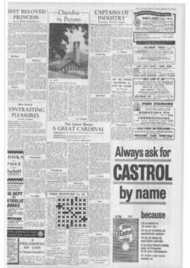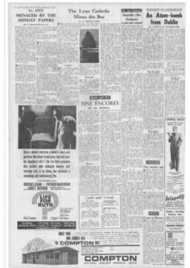Page 1, 14th September 1962
Page 1

Report an error
Noticed an error on this page?If you've noticed an error in this article please click here to report it.
Tags
Share
Related articles
'a Page Of History Has Been Turned'
Building In Liverpool Cathedral Precincts
Body Of Archbishop To Be Removed To Cathedral
The Silent Evangelists' Are Blessed
Mgr. Taylor For Gars Ton
GIANT CRANE ON BROWNLOW HILL
From Mgr. Cyril Taylor
LIVERPOOL, Wednesday.
WORK on building the new Liverpool Metropolitan Cathedral is expected to begin next week. The builders are awaiting the arrival from France of a giant 230-foot crane, claimed to be the largest of its type in the world, which is due at any moment.
Delivery of the crane has been delayed in transit by a strike hut it is now on its way to the site at Brownlow Hill, in midtown Liverpool. It will be transported in sections and assembled in situ.
"The crane will virtually build the Cathedral," said a spokesman for the builders, Messrs. Taylor Woodrow Construction, Ltd. "It will rise up through the middle and lift 90 per cent of the materials used in die construction."
Meanwhile, test borings for the foundations have been completed. The basic structure will be reinforced concrete in the shape of a vast cone of nearly 350 feet diameter at the base. The topmost pinnacles will reach about 300 feet ;those ground level.
It is nearly 110 years since Bishop Goss, co-adjutor to Dr. Brown. first Bishop of Liverpool, began collecting funds to build a Cathedral in city. The Lady Chapel, to the design of Edward Welby Pugin, was opened in 1856, but the scheme was abandoned because of the urgent need of schools. It is now the parish church of Our Lady Immaculate, Everton, In 1922, Archbishop Keating launched a fund to build a Cathedral as a memorial to his prede cessor, Dr. Whiteside, first Archbishop of Liverpool. At his daetith in 1928, assets stood at £122,000.
Dr. Downey popularised the scheme, bought the nine-acre Brownlow Hill workhouse site for £100,000 and commissioned Sir Edward Lutyens. In 1958 the total collected was just short of fl million. But the cost of Lutyen's design, conservatively estimated at £3 million before the war, had
risen astronomically and beyond all hope of achievement. It was abandoned.
Competition
Half the total collected was expended when the magnificent crypt was completed and brought into use. Archbishop Heenan then decided on a competition to find a design costing no more than million and to be completed in ten years. On August 15, 1960, Mr. Frederick Gibbcrd's design was proclaimed the winner. His concept of a circular building with the High Altar centred in the midst of 3,000 people won high praise from the crittcs.
With an average regular income of £50,000 annually the second halfmillion was assured in a decade. Then the architect announced he could complete the actual building in four years from the beginning of operations. They began in January this year.
Thus the need for a vast increase in income was aggravated. Consequently Dr. Heenan devised his master plan to raise the money. He gave each parish in the diocese a target based on his personal assessment of its ability to meet it. This was calculated to bring in £500,000 in five years.
Last Sunday when His Grace made his annual appeal for the Lady Chapel fund he made it known that the amounts collected would be credited against the parochial target. Last year this collection brought in £6,500. There is another each year on the feast of Christ the King, the titular of the cathedral.
blog comments powered by Disqus









